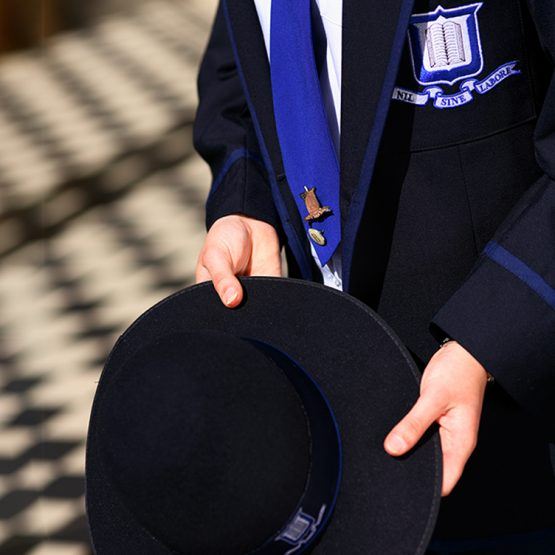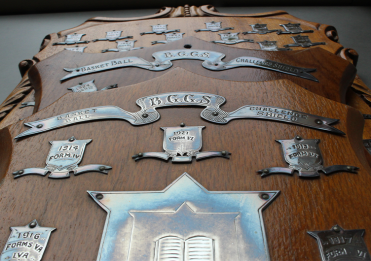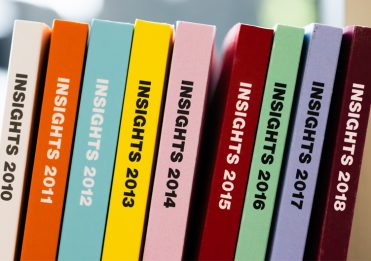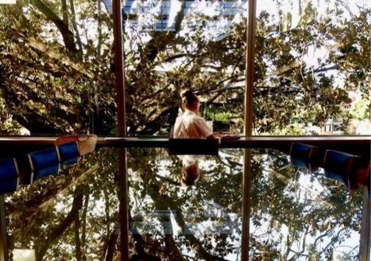
The 1966 Centralians Booklet with School Magazines and Box Brownie
There are times when the least exciting-looking or professional artefact reveals a wealth of information and insight into the lives of students. The celebratory booklet produced by the students of the first Central Australia trip is one such example. From the first School excursion to North Queensland in 1929, field trips at Grammar have always been one way for the School to deliver a broad, liberal, education and this 1966 trip certainly seemed to fit the bill.
The 1966 Central Australia trip was supported by Head Mistress, Mrs Louise McDonald, who felt it was important to broaden students’ horizons. Perhaps, Mrs McDonald, when supporting the Central Australia trip, was channelling Danish physician, Peter Severinus (1571), when he stated:
‘Go my children, … burn your books, … buy yourselves stout shoes, get away to the mountains, … the deserts, … and the deepest recesses of the earth; mark well the distinction between animals, the differences among plants, the various kinds of minerals … In this way, and no other, will you arrive at a knowledge of things, and of their properties.’
In her 1966 Annual Report, she explained that the intake of an extra level of students in 1964 had resulted in an expanding curriculum where ‘the fieldwork in biology, geology and geography has greatly widened their horizons and has been enjoyed by all’. A scientist herself, she had realised that field trips engaged and entertained students, making students think beyond the textbook, the four walls of the classroom or the picket fence on Gregory Terrace. After all, in 1953, when Mrs McDonald became Head Mistress, a group of Sixth Form (Year 12) students enjoyed what must have been a very exciting experience—a visit to the ACF and Shirley Fertilizer Works in Pinkenba to study the preparation of sulphuric acid for Senior Science!
Therefore, in 1966, 33 Fifth Form (Year 11) students and three staff members, Marjorie Neil (1957), Heather Tuckett (1958), and Daphne Tuckett (1960), embarked on the first Central Australia trip, travelling by bus over 10 000 kilometres in three weeks. This trip, by 21st century standards, might appear modest and decidedly unglamorous when compared to more recent journeys to places like Italy and England, but the joyfulness and enthusiasm detailed in these pages, duplicated on the School’s Fordigraph machine, are apparent to any reader.

1966: On the road to Augathella
One of the girls on the trip, Wendy Clarke (1967), recalls saying to Miss Neil at the end of the trip: ‘I want to go home, get some clean clothes and more money and go off again … it was just a fabulous experience.’ During her 2022 telephone conversation, Wendy then said ‘and what did I do a lot in my life? Went off and travelled!’

1966 Central Australia Trip booklet, Box Brownie, and 1966 School Magazine
The booklet written by the The Centralians on their return records their day-to-day adventures on the road and includes the words to a dozen songs made up along the way. Food was, and always has been, an important part of every Grammar girl’s trip—and this was no exception. A detailed entry of each meal eaten was included in the booklet, students on a later, 1972 Central Queensland trip, described their most unusual meal—a rubbery, jelly-like mess known as Camp Pie.

1966 Menu for the final four days of the trip
On their way through Queensland, the Northern Territory, and South Australia, the 1966 Centralians students saw Aboriginal rock art, visited mines, climbed Uluru, went boating down Katherine Gorge, crossed deserts, met drovers, and arrived at Port Augusta, having ‘crossed Australia from North to South’. They journeyed back up north via Canberra and Sydney and home to Brisbane three weeks later. This was the time well before mobile phones. Contact was much more difficult. Public telephones were few and far between and girls received handwritten letters from home, sent to different towns, and collected on the way. In Mount Isa, Lorraine Dunstan ‘set the record by receiving six letters’.

1966: Mine inspection group. Wendy Clarke third from the left
These trips to Central Australia continued for the next 12 years, integrating different teaching disciplines: geology; ecology; human environment; history; and art. Students found such trips to be transformative experiences, many agreeing the tour was an event ‘none of us will ever forget’, despite three weeks of canned food, freezing temperatures, and bogged buses!

1973 BGGS Magazine art ‘when the last of the lazy ones were dragged out, we got the bus out and, on its way …’ p34

1966: First Grammar Group to climb Uluru

1973 BGGS Magazine –Ayers Rock (Uluru) ‘with its deceptive climb’ p33
In the years since 1966, School trips locally or abroad, now labelled as ‘Experiential Learning Travel Opportunities’, still offer the same opportunities girls have been having since the 1920s—only to more exotic and exciting places, many across the globe. The Antipodeans Abroad have gone to India, Cambodia, Tanzania, and Peru. The Humanities staff took girls on Latin and Roman history tours to England and Italy, and the ever-popular US Space tours travelled to Alabama, Orlando, Washington DC, and San Francisco. Teams of girls have travelled all over the world to represent the School as youth leaders, athletes, debaters, scientists, physicists, and mathematicians. Since COVID, it has taken some time for the School to get back on the travel express but 2022 has seen students travelling more widely once more.
However, that 1966 Central Australia trip was ground-breaking, offering life-wide learning opportunities in a totally different environment from day-to-day School in Brisbane. The friendships formed and the memories created have lasted long beyond those three weeks in a bus. Past students at reunions reminisce fondly about the unforgettable sights, the food they ate, and the fun they all had together.
Mrs Jenny Davis
Librarian—Special Collections

1966: Drovers near Blackall
References:
1966 Brisbane Girls Grammar School Head Mistress Annual Report
1966 and 1973 BGGS Magazine
Clarke, Wendy Telephone conversation, 12 October, 2022.
Sheppard, Paul R., Rebecca Lipson, David Hansbrough and Joan Gilbert. Field-trip Pedagogy for teaching “Sense of Place” in Middle School, Science Scope, March 2013, Vol. 36, No. 7, Science and Students’ Interests (March 2013), pp. 49-54.
Whitmeyer, S.J., and D.W. Mogk. 2009. Geoscience field education: A recent resurgence. EOS, Transactions, American Geophysical Union, 90 (43) 385-387.




